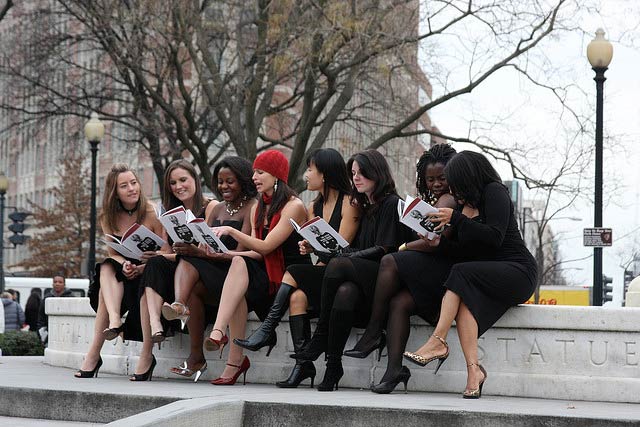For centuries now, black has been an indispensable color in men’s clothing though its associations have changed according to different periods in history.
Sometimes black has indicated death, at other times, sin and in other times still, power and security. If you are one of those who can’t pass up on black clothes, there are some things you should know about the color.
There is no question that part of the reason why black has always been in style is that it has its own unique style. Black makes people look elegant, it draws attention to one’s face, it is a symbol of nobility and stylishness and it generally brings to mind the concept of power and strength. At least, these are the associations that black outfits bring to mind currently. But in earlier times, black was associated with death, evil, sin, bad luck and illness. Darkness was linked to night time, night time was linked to death and all this was reflected in the color black. Warriors used to paint their faces and bodies black to remind the other side of death and thus scare them during warfare.
Black is the height of fashion
Though women often turn to black when it comes to dressing, it seems that this color has in fact been most indispensable for men over the ages. Going back over the centuries, you can find men dressed entirely in black for all sorts of different reasons.
A book, Men in Black by John Harvey, delves into precisely this topic. The book is an important project that scrutinizes the various reasons why men have worn black through different periods of history. Even if you are only slightly interested in the history of fashion, I definitely recommend this book.
High fashion circles now use black even more for women than they do for men. And in fact, this makes us think that, as a color, black is the height of fashion. But Harvey has an interesting take on this situation: “If black maintains its primary stance in the world of fashion, this is connected not to it being a distinctive color but to memories of the meanings it held in the past.”
What meanings did black hold in past?
It was in the 19th century that the perception of black as a fashionable color began to spread more and more. We see from images from the Middle Ages that in those centuries, when men had power and money, they would dress as colorfully as possible. In fact, the same was true even for the lesser well-off; wearing a red or blue hat with clothes that were brown or green was not unusual in those times! In the 15th and 16th centuries, black was fashionable to a certain extent but not everyone would wear it.
From the 19th century onwards, people began wearing deeper and more somber colors. By the time 1830 rolled around, evening tuxedos and suits were dominated by the color black. Summer pants around this period were white but in later years, black pants became traditional. Even the lifespan of the colorful cravat was not very long. In The Gentleman’s Magazine of Fashion published in 1838, remarks were made about King George IV and his predilection for black, and how he had rejected white cravats except for more unusual occasions. In the Tailor’s Journal published in France in 1850, it is noted that official men’s clothing was now only a black shirt, black pants, a white vest and a black tie. This is really an interesting change though. Apparently men were now choosing to wear chic versions of mourning outfits which managed make the 19th century look like one large funeral ceremony.
According to author Harvey, we are now living out the period following the final peaking of the wave of black. Now, the most important reason for such a widespread use of black is the connection it has to power. “A man wearing black, whether he stands alone or with others, is a representation of serious strength and power, one which also indicates power over women,” says Harvey. For whatever reasons, getting rid of black items of clothing just doesn’t seem possible. Whether people are trying to look more powerful or merely to reflect a religious identity, the fact is that black always makes people appear striking, which is why it is not a color that will be soon passed on by anyone.
The European ruler who made black fashionable
As in the case of British monarch George IV, there were many rulers over the years who helped to spread the color black. Harvey’s book mentions Spanish King Philip II, who ruled Spain from 1556 to 1598, who wore black constantly while overseeing his reign of terror. It became so associated with the workings of the palace that all of his royal assistants also wore black. The writer notes that the wearing of black by King Philip II was also associated with fears over losing Spain and that black was a show of power in the face of these fears.
Powerful nations determine fashion
Another conclusion reached by Harvey in his book has to do with the ties between the color black and empires. “Whenever a European state would embrace as a society the color black, this would be when that nation was at the height of its international power,” he asserts. And in truth, looking back on European history, we see that black was very popular as a outfit color and widespread in fashion in 15th century Burgundy, 15th and 16th century Venice, 16th century Spain, 17th century Holland and 19th century England. After all, this was a color which, before being worn by rulers and the nobility of Europe, stood as a symbol of power and strength in civilizations. Between the 11th and 17th centuries, Chinese emperors also wore black clothing very frequently. In any case, there is a definite link shown here between being important and the color black. This color can also be linked to empires wishing to ensure that they would last. According to Harvey, when kings wore black throughout the ages, it was linked to their desire for authority, discipline and sternness.






